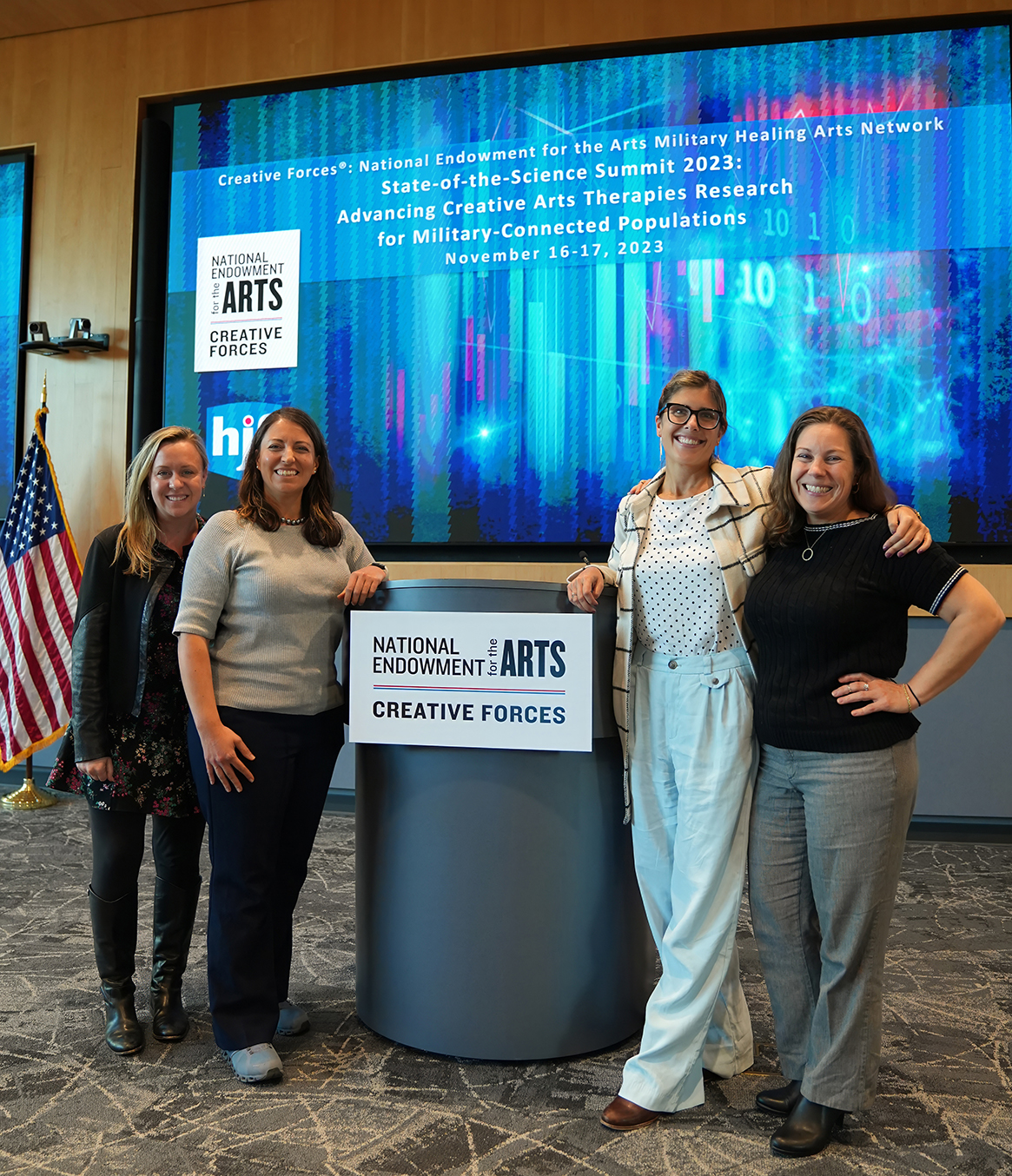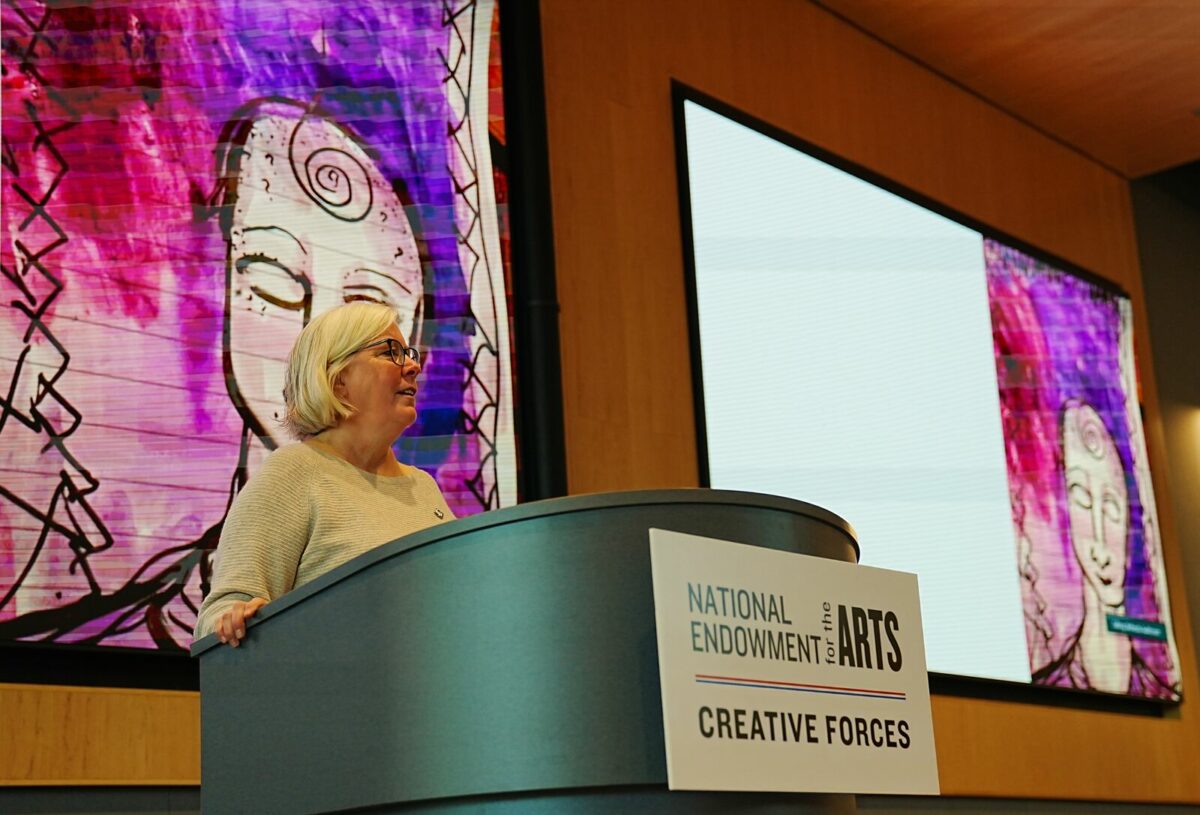Clinical Program
Creative arts therapies like art therapy, dance/movement therapy, and music therapy can promote rehabilitation and recovery for military-connected people, making a difference in their lives.
The Clinical Program embeds creative arts therapies in military healthcare settings across the country, including through telehealth.
Our team also influences the broader healthcare system by advancing research, practice, and policy.

About creative arts therapy
Creative arts therapies can help people achieve optimal physical and mental health, resilience, social integration, and quality of life.
Creative arts therapies help patients:
- Process emotions and traumatic experiences
- Increase self-awareness and self-esteem
- Reduce hyperarousal, avoidance, and depression
- Decrease social isolation.
Creative arts therapies also address cognition, motor, speech/language functioning, and chronic pain.
Creative arts therapists
Through the Creative Forces Clinical Program, creative arts therapists, known as CATs, provide creative arts therapies for military and veteran patients. Therapies are provided in clinical settings at Department of Defense (DoD) and Veterans Affairs (VA) medical facilities and through telehealth.
View our clinical locations map
Creative Forces CATs are employees of the DoD, VA, or the Henry M. Jackson Foundation for the Advancement of Military Medicine, Inc. (HJF).
Patient-centered care
Creative Forces places creative arts therapies at the core of patient-centered care. This means CATs work on interdisciplinary teams in treatment programs that focus on supporting each patient’s unique needs.
Watch our Clinical Program overview
Meet some of the Clinical Program team, as they discuss key aspects of their work with patients.
Clinical Program overview video transcript
[MUSIC PLAYING] Creative Forces NEA Military Healing Arts Network supports the integration of creative arts therapies including art therapy, music therapy, and dance movement therapy in military clinics and VA hospitals across the country.
Creative Forces art therapists use standardized assessments like mask-making, the bridge with path drawing, and the wellness wheel to help determine the goals of the individual patient. Art therapy allows our patient population to visually express thoughts and feelings about their injuries and identities that they may not otherwise have been able to describe. They can then process these themes with the therapist.
Creative Forces dance movement therapists use interventions such as mirroring the journey dance method and mind-body skills training to gain information from patients that shapes clinical decision-making. These embodied in movement-based interventions can increase self-efficacy and help patients reach their behavioral health and rehabilitative goals.
Music therapy interventions such as personal music inventory, lyric analysis, and songwriting promote emotional associations, meaning-making, and processing of experiences. Instrument playing supports motor function, musical sequencing, and learning processes that promote cognition. Deep breathing and singing reinforce speech and language.
The Creative Forces team is constantly working on building resources for our creative arts therapists.
These include a series of clinical practice training videos that illustrate how to modify standard interventions for our patients in the military community. Other resources include intervention and evaluation tool kits, standardized note templates, referral documents, performance management tools, presentation and brochure templates, standardized assessments, and research protocols. Sharing our research with others in the creative arts therapy world is also a critical part of our mission.
Due to the collective efforts of the Creative Forces Network, we’ve published numerous articles based on best practices and clinically based research outcomes.
Our many articles are available open access and can be found cataloged on our National Resource Center.
Our network also gives us the tools to respond to pressing needs in changing times. During the COVID-19 pandemic, we quickly trained and mobilized our creative arts therapists to treat patients via telehealth.
Our network of creative arts therapists, peers, leadership, clinical, research, and administrative teams is what enables us to build strong programs and practices and to have the greatest possible impact on military service members, veterans, and their families and caregivers.
For more information, refer to the National Resource Center at creativeforcesnrc.arts.gov.
[MUSIC PLAYING]
Accessibility Statement
Creative Forces’ full Accessibility policy is linked in the footer.
Types of creative arts therapies
Art therapy
Patients use art materials to express themselves with the guidance of an art therapist. With the therapist, patients talk through the themes that emerge in their artwork.
Methods include:
- Making a mask to process change and express themes about one’s identity and sense of self
- Engaging in anxiety-reducing arts processes, like pour painting
Music therapy
Patients use music to identify, express, and process their experiences and emotions. Music therapists guide patients through activities that can help them achieve their goals.
Methods include:
- Playing instruments to support motor coordination, cognition, and relationships
- Singing to improve breath support and speech
Dance/movement therapy
Patients use dance and movement to promote healing, with the guidance of dance/movement therapists. Dance/movement therapy helps patients understand their mind body connection.
Methods include:
- Mirroring another person’s movements to increase social engagement and support self-exploration
- Mind-body skills training to improve autonomic nervous system regulation and manage chronic pain
Art therapy opened up a lot in me. It actually saved my life. It kind of saved my marriage. It got me back on a road to recovery, and that’s where we are now.
Christopher Stowe, MGySgt, U.S. Marine Corps (Retired)
(External link)Watch a video about how creative arts therapy has affected the lives of military service members and veterans, which was originally developed as part of our “Healing the Invisible Wounds of War” online exhibition.
Clinical locations
The Creative Forces Network places creative arts therapists in clinical sites across the nation. We work at military hospitals and veterans facilities in collaboration with the U.S. Departments of Defense and Veterans Affairs.

Department of Defense clinical site locations
-
Anchorage, Alaska
-
Joint Base Elmendorf-Richardson (JBER)
-
-
Colorado
-
Fort Carson
-
-
Bethesda, Maryland
-
National Intrepid Center of Excellence (NICoE) at Walter Reed
-
-
Jacksonville, North Carolina
-
Marine Corps Base Camp Lejeune
-
-
Texas
-
Fort Cavazos
-
-
Washington
-
Joint Base Lewis-McChord (JBLM)
-
-
Virginia
-
Fort Belvoir
-
Veterans Affairs clinical site locations
-
Gainesville, Florida
-
North Florida/South Georgia Veterans Health System
-
-
Tampa, Florida
-
James A. Haley Veterans’ Hospital
-
-
Indianapolis, Indiana
-
Richard L. Roudebush VA Medical Center
-
-
Jackson, Mississippi
-
G.V (Sonny) Montgomery VA Medical Center
-
-
Cleveland, Ohio
-
VA Northeast Ohio Healthcare System
-

Bridging research and practice
We invest in research on the physical, social, and emotional impacts and benefits of creative arts therapies. In partnership with the Department of Defense and Veterans Affairs, Creative Forces aims to advance knowledge, leverage subject-matter expertise, and promote the use of best practices.
Creative Forces clinical research investigates how creative arts therapies impact:
- Recovery from traumatic experiences
- Reduction of the symptoms of traumatic brain injury (TBI), post-traumatic stress disorder (PTSD), and chronic pain
- Improved emotional expression and awareness
- Reduction of isolation and stigma
- Increased interpersonal relatedness and positive emotion
Creative Forces has also conducted research on the feasibility and effectiveness of creative arts therapies in military treatment facilities, in outpatient treatment settings, and through telehealth.
Creative Forces clinical research findings have been published in 25 peer-reviewed articles since 2016.